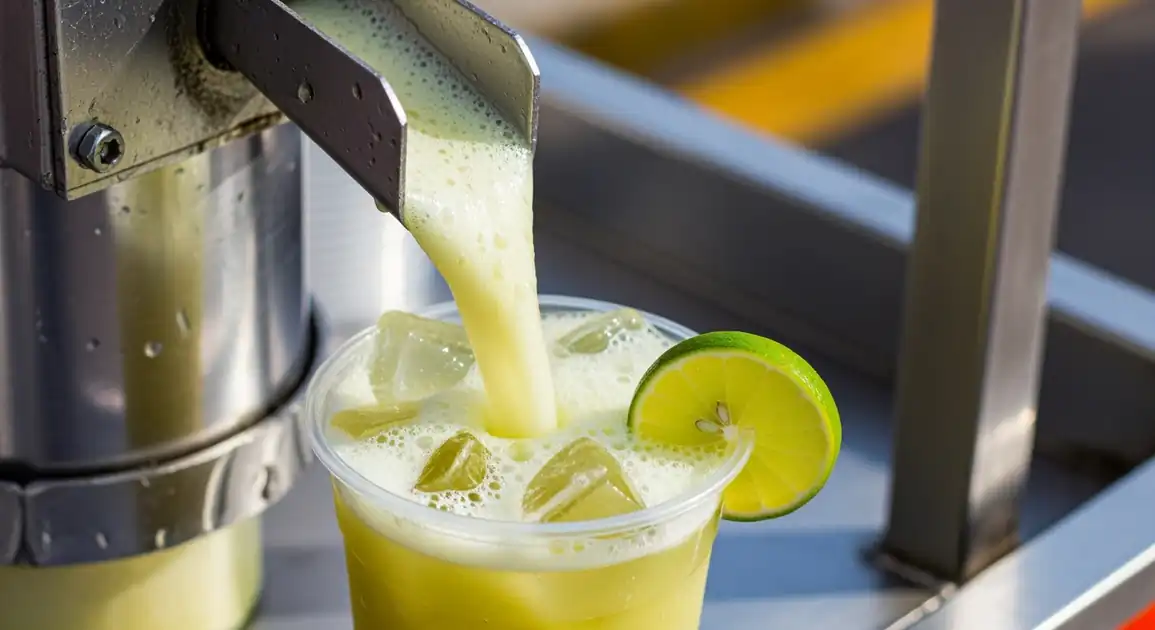Caldo de Cana com Limão (Sugarcane Juice with Lime)
Caldo de Cana com Limão

Description
Caldo de Cana is a ubiquitous and beloved street drink found throughout Brazil. It's particularly common at outdoor markets ('feiras livres'), roadside stalls, beaches, and parks. Often sold alongside 'pastel' (fried pastry), it's a classic and affordable refreshment.
Dietary Information
Serving information
Serving style
Served cold in a plastic cup, freshly pressed. Lime is typically squeezed in front of you. Consumed immediately.
Quick facts
Highly variable. Market vendors follow market hours (often 7 AM - 1 PM). Roadside stalls often operate longer daytime hours (e.g., 9 AM - 6 PM).
Safety Tips
What to Look For
-
Visibly clean pressing machine (rollers, spout, tray).
Residue buildup can harbor bacteria. Ensure the parts contacting the juice look well-maintained and recently cleaned.
-
Fresh, moist-looking sugarcane stalks.
Dry or old cane yields less juice and may indicate lower quality standards.
-
Vendor using clean practices (hand washing, clean cloths).
Good hygiene prevents cross-contamination when handling cane, lime, cups, and money.
-
Use of seemingly clean water for rinsing (if observed).
Dirty rinse water can contaminate cups or the machine.
-
Clear ice, preferably from bagged/filtered source.
Avoid cloudy block ice if possible, as its water source might be questionable. Ordering 'sem gelo' (no ice) bypasses this risk.
-
High customer traffic.
Indicates the juice is pressed frequently and ingredients are likely fresh.
What to avoid
-
Dirty machine with visible grime, residue, or insects.
Major hygiene red flag. Do not buy from such vendors.
-
Dry, brown, or moldy sugarcane stalks.
Indicates old or improperly stored cane.
-
Vendor with poor personal hygiene or handling practices.
Increases risk of contamination.
-
Use of cloudy ice blocks or visibly dirty water.
Potential source of waterborne contaminants. Best to avoid ice in these cases.
-
Juice that looks unusually dark brown or smells fermented.
Fresh sugarcane juice is light greenish-yellow. Darkening or fermented smell indicates spoilage.
Price information
Price range
Budget tips
- Prices vary by location (cheaper in local markets, more expensive in tourist areas/beaches).
- Usually sold in standard cup sizes (e.g., 300ml, 500ml, 700ml).
- It's generally one of the most affordable fresh drinks available.
Value indicators
- Freshly pressed on the spot.
- Good balance of sweetness and lime tang (if ordered 'com limão').
- Served cold and frothy.
- Clean vendor setup.
Where to Find This Dish
Feiras Livres (Street Markets)
A quintessential part of the Brazilian street market experience, often found near pastel stalls.
Weekly neighborhood markets
Market mornings (usually 7 AM - 1 PM)
Roadside Stalls ('Barracas')
Common along highways, busy roads, and near beaches or parks.
Bus stops, Beachfront promenades, Park entrances
Daytime
Permanent Markets
Larger municipal markets often have dedicated stalls.
Mercado Municipal
Market hours
Vendor Tips
- Specify 'com limão' (with lime) or 'sem limão' (without lime).
- Specify 'com gelo' (with ice) or 'sem gelo' (without ice).
- Look for vendors actively pressing fresh cane.
How to Order
Regional Variations
-
Caldo de Cana Puro
(Caldo de Cana Puro)
Plain sugarcane juice without any additions like lime.
-
Caldo de Cana com Limão
(Caldo de Cana com Limão)
The most popular version, with fresh lime juice squeezed in to balance the sweetness.
-
Caldo de Cana com Abacaxi
(Caldo de Cana com Abacaxi)
Sugarcane juice blended or pressed with fresh pineapple, adding tropical fruitiness.
-
Caldo de Cana com Gengibre
(Caldo de Cana com Gengibre)
Sugarcane juice blended or pressed with fresh ginger, adding a spicy kick.
Cultural context
History
Sugarcane has been a major crop in Brazil since colonial times. The simple method of extracting juice by pressing the stalks likely emerged early on. Caldo de Cana became a popular and affordable drink for hydration and energy, especially for workers. Its presence grew with urbanization, becoming a staple at street markets ('feiras') and roadside stalls, often famously paired with 'pastel' (fried pastry).
Local significance
An iconic symbol of Brazilian street culture – simple, natural, refreshing, and affordable. Deeply associated with everyday life and leisure.
Eating customs
- Drunk immediately while standing near the cart/stall.
- Consumed quickly as a thirst quencher.
- Often enjoyed as a quick energy boost.